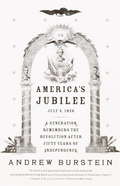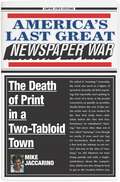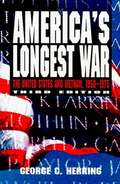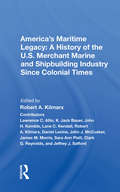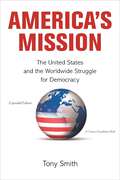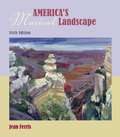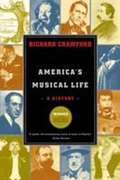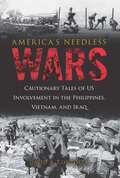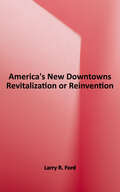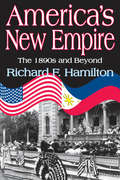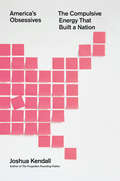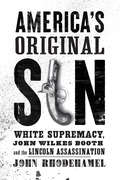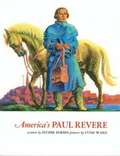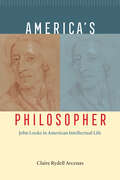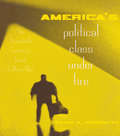- Table View
- List View
America's Jubilee: A Generation Remembers the Revolution After 50 Years of Independence
by Andrew BursteinIn America's Jubilee distinguished historian Andrew Burstein presents an engrossing narrative that takes us back to a pivotal year in American history, 1826, when the reins of democracy were being passed from the last Revolutionary War heroes to a new generation of leaders. Through brilliant sketches of selected individuals and events, Burstein creates an evocative portrait of the hopes and fears of Americans fifty years after the Revolution. We follow an aged Marquis de Lafayette on his triumphant tour of the country; and learn of the nearly simultaneous deaths of John Adams and Thomas Jefferson on the 4th of July. We meet the ornery President John Quincy Adams, the controversial Secretary of State Henry Clay, and the notorious hot-tempered General Andrew Jackson. We also see the year through the eyes of a minister's wife, a romantic novelist, and even an intrepid wheel of cheese. Insightful and lively, America's Jubilee captures an unforgettable time in the republic's history, when a generation embraced the legacy of its predecessors and sought to enlarge its role in America's story.
America's Last Great Newspaper War: The Death of Print in a Two-Tabloid Town
by Mike JaccarinoNAMED A BEST BOOK OF THE WEEK BY THE NEW YORK POSTALSO AVAILABLE AS AN AUDIOBOOKA from-the-trenches view of New York Daily News and New York Post runners and photographers as they stop at nothing to break the story and squash their tabloid arch-rivals.When author Mike Jaccarino was offered a job at the Daily News in 2006, he was asked a single question: “Kid, what are you going to do to help us beat the Post?” That was the year things went sideways at the News, when the New York Post surpassed its nemesis in circulation for the first time in the history of both papers. Tasked with one job—crush the Post—Jaccarino here provides the behind-the-scenes story of how the runners and shooters on both sides would do anything and everything to get the scoop before their opponents.The New York Daily News and the New York Post have long been the Hatfields and McCoys of American media: two warring tabloids in a town big enough for only one of them. As digital news rendered print journalism obsolete, the fight to survive in NYC became an epic, Darwinian battle. In America’s Last Great Newspaper War, Jaccarino exposes the untold story of this tabloid death match of such ferocity and obsession its like has not occurred since Pulitzer– Hearst.Told through the eyes of hungry “runners” (field reporters) and “shooters” (photographers) who would employ phony police lights to overcome traffic, Mike Jaccarino’s memoir unmasks the do-whatever-it-takes era of reporting—where the ends justified the means and nothing was off-limits. His no-holds-barred account describes sneaking into hospitals, months-long stakeouts, infiltrating John Gotti’s crypt, bidding wars for scoops, high-speed car chases with Hillary Clinton, O.J. Simpson, and the baby mama of a philandering congressman—all to get that coveted front-page story.Today, few runners and shooters remain on the street. Their age and exploits are as bygone as the News–Post war and American newspapers, generally. Where armies once battled, often no one is covering the story at all.Funding for this book was provided by: Furthermore: a program of the J. M. Kaplan Fund
America's Last Wild Horses
by Hope RydenFrom the Book Jacket: "A richly researched and written book with an unusual appeal." -Publishers Weekly "This book is a treat for everyone who knows or cares about horses." -Cleveland Amory No wild animal captures the spirit of North America quite so powerfully as the wild horse-nor has any faced such diverse and potent enemies. In this provocative account, Hope Ryden-who helped to ensure the passage of the Wild and Free-Roaming Horse and Burro Act, which grants mustangs special protection-combs the history of these proud and noble horses; Descended from the Spanish horses ridden by the conquistadors, they evolved into the tough and intelligent ponies that Indians-and later, explorers and cowboys-learned to rely on. From the period when wholesale extermination of the buffalo was underway until recent times, commercial and political interests have sought to eliminate the wild horses as varmints. In the latest update to this classic story Ryden tells of the successes: and failures in the past ten years of regulation, and has added stunning new color photographs. The subject of a front-page article in The New York Times. when it was first published, america's last wild horses continues to be a compelling testament to the life of a uniquely American symbol of grace and wildness, and is a must read for horse lovers and Western history enthusiast everywhere.
America's Little Italys: Recipes and Traditions from Coast to Coast
by Sheryll BellmanThe Italian Immigrant Experience Who could ever imagine a life without opera, pizza, or great art? These wonderful contributions of Italian culture have greatly influenced the American cultural landscape. During the nineteenth century, Italian immigrants came to the United States to forge a better, safer, and more prosperous life. They brought with them rich traditions that included love for romance, literature, science, commerce, style, and of course, most notably -- food.
America's Longest Siege: Charleston, Slavery, and the Slow March Toward Civil War
by Joseph Kelly“[A] vivid and engrossing study of slavery in and around one of its trading hubs, Charleston, SC . . . an important contribution to Southern antebellum history.” —Library JournalIn America’s Longest Siege, historian Joseph Kelly captures the toxic mix of nationalism, paternalism, and wealth that made Charleston the center of the nationwide debate over slavery and the tragic act of secession that doomed both the city and the South. Thoroughly researched and compulsively readable, America’s Longest Siege offers a new take on the Civil War and the culture that made it inevitable.“Lays bare the decades-long campaign of rationalization and intimidation that revivified and reinforced the institution of slavery and dragged the United States into disunion and civil war . . . this masterful study is a timely and important reminder of the consequences that result when ideological extremists succeed in drowning out the voices of reason.” —Peter Quinn, author of Hour of the Cat
America's Longest War: The United States and Vietnam, 1950-1975 (3rd edition)
by George C. HerringAmericas Longest War provides a complete and balanced history of the Vietnam War. It is not mainly a military history, but seeks to integrate military, diplomatic, and political factors in order to clarify America's involvement and ultimate failure in Vietnam.
America's Maritime Legacy: A History Of The U.s. Merchant Marine And Shipbuilding Industry Since Colonial Times
by Robert A. KilmarxThis book presents a comprehensive historical analysis of merchant shipping on the high seas and associated shipbuilding under sovereign U.S. jurisdiction from precolonial times to the present. It identifies U.S. policy developments that have affected the merchant marine and shipbuilding industries.
America's Medicis: The Rockefellers and Their Astonishing Cultural Legacy
by Suzanne LoeblFrom literary polymath Suzanne Loebl (the author of ten books, most recently the acclaimed America’s Art Museums) comes the captivating, first-of-its kind exploration into the philanthropic and cultural legacy of one of America’s wealthiest and most influential families: The Rockefellers. Fueled by John D. Rockefeller’s vast petroleum fortune, the entire family’s terrific passion for the arts transformed the artistic infrastructure of twentieth century America. Funding museums like the MoMA, the Cloisters, the Metropolitan Museum of Art, the Museum of the Oriental Art at the University of Chicago, and commissioning major architectural projects like Rockefeller Center, Riverside Church, and Lincoln Center, the Rockefellers’ achievements forever changed the cultural landscape of the Western world. Loebl’s penetrating biography is the first book to deeply explore the family’s critical role as collectors and patrons of the arts.
America's Mission: The United States and the Worldwide Struggle for Democracy - Expanded Edition (Princeton Studies in International History and Politics #139)
by Tony SmithAmerica's Mission argues that the global strength and prestige of democracy today are due in large part to America's impact on international affairs. Tony Smith documents the extraordinary history of how American foreign policy has been used to try to promote democracy worldwide, an effort that enjoyed its greatest triumphs in the occupations of Japan and Germany but suffered huge setbacks in Latin America, Vietnam, and elsewhere. With new chapters and a new introduction and epilogue, this expanded edition also traces U.S. attempts to spread democracy more recently, under presidents Clinton, Bush, and Obama, and assesses America's role in the Arab Spring.
America's Mistress: The Life and Times of Miss Eartha Kitt
by John L. WilliamsStrait-laced, pre-civil rights America wasn't ready for Eartha Kitt. Waiting for others to be ready was never her style. in America's Mistress John L. Williams captures the person behind the myth in this engaging biography but also race relations in Twentieth-century America.From humble roots on a South Carolina cotton plantation, the multilingual, possibly multi-racial chanteuse emerged seemingly from nowhere to seduce the nation and redefine cosmopolitan glamour. Blending intellect, self-awareness and unprecedented sex appeal, she was a Technicolor presence in a black-and-white world. But the key to her allure was always her mystery, and her three not-entirely-consistent autobiographies raise more questions than they answer about who she really was--whether singing, dancing, acting or drawing headlines for her romantic dalliances and political activism. Drawing on extensive original research and interviews with the people who knew her best, Williams delivers a comprehensive, compassionate and thought-provoking record of a life that defied stereotypes, shattered boundaries, yet seemed to fall short of its potential in the end.America's Mistress is ultimately a celebration of a remarkable American life that paved the way for black entertainers from Belafonte to Beyoncé. With objectivity and thoroughness, John L. Williams provides sought-after answers to tantalizing and elusive questions.sex kitten.Whether or not her decline began with her 1968 infamous public confrontation with Lady Bird Johnson (that left the First Lady in tears), the later decades of Eartha's life were marked by America's growing indifference to the woman who once captured its attention like no one before or since.But America's Mistress is ultimately a celebration of a remarkable American life that paved the way for black entertainers from Belafonte to Beyoncé. With objectivity and thoroughness, John L. Williams provides sought-after answers to tantalizing and elusive questions.
America's Modern Wars: Understanding Iraq, Afghanistan, and Vietnam
by Christopher A. Lawrence&“A well researched and well analyzed study of the nature of insurgencies and guerilla warfare&” (Military Review). The fighting skills and valor of the US military and its allies haven&’t diminished over the past half-century—yet our wars have become more protracted and decisive results more elusive. With only two exceptions—Panama and the Gulf War under the first President Bush—our campaigns have taken on the character of endless slogs without positive results. This fascinating book takes a ground-up look at the problem to assess how our strategic objectives have become divorced from our true capability or imperatives. The book presents a unique examination of the nature of insurgencies and the three major guerrilla wars the United States has fought in Iraq, Afghanistan, and Vietnam. It is both a theoretical work and one that applies the hard experience of the past five decades to address the issues of today. As such, it also provides a timely and meaningful discussion of America&’s current geopolitical position. It starts with the previously close-held casualty estimate for Iraq that The Dupuy Institute compiled in 2004 for the US Department of Defense. Going from the practical to the theoretical, it then discusses a construct for understanding insurgencies and the contexts in which they can be fought. It applies these principles to Iraq, Afghanistan, and Vietnam, assessing where the projection of US power can enhance our position and where it merely weakens it. It presents an extensive analysis of insurgencies based upon a unique database of eighty-three post-WWII cases. The book explores what is important to combat and what is not important to resist in insurgencies. It builds a body of knowledge, based upon a half-century&’s worth of real-world data, with analysis, not opinion. In these pages, Christopher A. Lawrence, the President of The Dupuy Institute, provides an invaluable guide to how the US can best project its vital power while avoiding the missteps of the recent past. &“Provides a unique quantitative historical analysis . . . Logically estimating the outcomes of future military operations, as the author writes, is what US citizens should expect and demand from their leaders who take this country to war.&” —Military Review
America's Musical Landscape
by Jean FerrisThis textbook for music appreciation undergraduates surveys American music, relating it to the other arts and social and cultural contexts. Ferris (music history and appreciation, Arizona State U.) first explains the elements of music, then takes the reader on a chronological tour of American music, from North American Indian and folk music to contemporary mainstream concert music. Along the way, religious and secular music are discussed, as well as nineteenth century popular and concert music; country, folk, jazz, Latin music, and rock and roll; and musical theater, film music, and American opera. Listening charts are incorporated. This edition has been updated and reorganized, the amount of vernacular music has been expanded, and the recordings have been updated to match. Timelines are also new. No bibliography is provided. Annotation ©2006 Book News, Inc., Portland, OR (booknews.com)
America's Musical Life: A History
by Richard CrawfordAn Introduction to America's Music tells the fascinating story of music in the United States, from the sacred music of its earliest days to the jazz and rock that enliven the turn of the millennium. Beginning with the music of Native Americans and continuing with traditions introduced by European colonizers and Africans brought here as slaves, the book reveals how this bountiful heritage was developed and enhanced in the nineteenth and twentieth centuries to produce the music we hear today.
America's Needless Wars: Cautionary Tales of US Involvement in the Philippines, Vietnam, and Iraq
by David R. ContostaThis eye-opening book takes a unique approach to the history of U.S. foreign policy by examining three unrelated conflicts, all of which ended tragically and resulted in the deaths of millions on both sides. By analyzing what went wrong in each case, the author uncovers a pattern of errors that should serve as a precaution for future decision makers contemplating a conflict abroad. Why did President McKinley oppose Filipino independence forces if his motivation was truly to help Filipinos overthrow Spanish domination? Why did several U.S. presidents ignore the failures of the French in Vietnam and reject peace overtures from popular revolutionary leader Ho Chi Minh to bring the conflict to an early end? And how could American leaders have been so wrong about Saddam Hussein's alleged weapons of mass destruction and then let Iraq devolve into chaos after overthrowing the dictator? Historian David R. Contosta has sifted through official hearings, media investigations, public documents, memoirs of those for and against the conflicts, and numerous histories to uncover the answers to these questions. The common thread that links these wars from different centuries is that political leaders all too often have acted out of ignorance, arrogance, fear, and partisan gamesmanship. These lapses were compounded by the failure of the media to inform the public accurately and dispassionately. The sad result is that America has paid a high price in lost lives and tarnished national reputation. As the author notes in conclusion, if American exceptionalism is to have any meaning, then we must honestly appraise our past foreign-policy blunders to ensure wiser political action in the future.
America's New Downtowns: Revitalization or Reinvention? (Creating the North American Landscape)
by Larry R. FordWhat makes a good downtown, and why? Are today's downtowns, with their waterfront parks, festival markets, sports arenas, and cultural centers, more vibrant and lively than the "central business districts" of the nineteenth and early twentieth centuries? Was there ever a "golden age" of downtowns? In this book, noted urban scholar Larry Ford casts a critical and practiced eye on sixteen contemporary urban centers to offer an expert's view of the best―and worst―of downtown America. Ford begins with a brief history of U.S. urban development. He then explains his criteria for evaluating downtowns before proceeding with an on-the-street examination of the featured sixteen cities. Each is rated based on use of physical site, particularly for housing (unlike suburbs, Ford notes, most downtowns are located in challenging physical locales, such as harbors, rivers, hills, or peninsulas), street morphology, civic space, functional aspects (office space, retail stores, and convention centers), and the support districts in the fringe areas surrounding the downtown core. Ford concludes with a suggested model of downtown structure based upon the case studies and with a look at the possible effects of increasing globalization on the downtowns of the late twenty-first century. This book will appeal to those interested in urban studies, landscape studies, American studies, architecture, historic preservation and planning, and urban geography. Featured cities: Atlanta, Baltimore, Charlotte, Cleveland, Columbus, Denver, Indianapolis, Minneapolis, Phoenix, Pittsburgh, Portland, Providence, San Antonio, San Diego, Seattle, and St. Louis
America's New Empire: The 1890s and Beyond
by Richard F. HamiltonIn this volume, Hamilton deals with some of the antecedents and the outcome of the Spanish-American war, specifically, the acquisition of an American empire. It critiques the "progressive" view of those events, questioning the notion that businessmen (and compliant politicians) aggressively sought new markets, particularly those of Asia. Hamilton shows that United States' exports continued to go, predominantly, to the major European nations. The progressive tradition has focused on empire, specifically on the Philippines depicted as a stepping stone to the China market. Hamilton shows that the Asian market remained minuscule in the following decades, and that other historical works have neglected the most important change in the nation's trade pattern, the growth of the Canada market, which two decades after the 1898 war, became the United States' largest foreign market.The book begins with a review and criticism of the basic assumptions of the progressive framework. These are, first, that the nation is ruled by big business (political leaders being compliant co-workers). Second, that those businessmen are zealous profit seekers. And third, that they are well-informed rational decision-makers. A further underlying assumption is that the economy was not functioning well in the 1890s and that a need for new markets was recognized as an urgent necessity, so that big business, accordingly, demanded world power and empire. Each of these assumptions, pivotal elements in the dominant progressive tradition in historical writing, is challenged, with an alternative viewpoint presented.Hamilton presents a different, more complex view of the events following the Spanish-American War. The class-dominance theory is not supported. The alternative argued here, elitism, proves appropriate and more useful. This review and assessment of arguments about American expansion in the 1890s adds much to the literature of the period.
America's New Map: Restoring Our Global Leadership in an Era of Climate Change and Demographic Collapse
by Thomas P.M. BarnettThree tectonic and inevitable shifts have left the world at a crossroads. North America is poised to either re-emerge as a global leader, or turn back in time, ceding power and influence to competitors. The 21st century unleashed unprecedented changes across the globe—to its climate, to the demographic makeup of its nations, and to the very nature of allegiance in the digital age. With its global influence waning, America must reevaluate its approach to globalization if it wishes to remain a leader. In America&’s New Map: Restoring Global Leadership in an Era of Climate Change and Demographic Collapse, Thomas P.M. Barnett, bestselling author of The Pentagon&’s New Map: War and Peace in the Twenty-First Century and acclaimed geo-strategist, offers seven throughlines to frame and redefine the ambitions and posture of these United States, setting our Union on a bold-but-entirely-familiar national trajectory. In these pages, Barnett offers a deep, yet accessible dive into the three shifts that have lead us to this point: As climate change ravages countries closest to the equator, global dynamics are shifting from an East-West emphasis to North-South in the greatest geopolitical transformation our world has yet experienced—and the Western Hemisphere is far better positioned to exploit this radical reorientation than the East. Aging demographics worldwide favor more slowly aging nations, including the US, while challenging rapidly aging nations like China, incentivizing countries best to delay that transition by integrating younger, faster-growing populations into their ranks. In combination, these two tectonic forces collide with a third: the exploding consumption of an expanding—and now majority—global middle class, the bulk of whom reside along the increasingly unstable North-South frontier. Taking every variable of these unique circumstances into account, America&’s New Map charts a path toward a bigger and better United States. We will all be living in somebody&’s world come mid-century—this book tells Americans how to make sure it is one we can recognize as our own.
America's Obsessives: The Compulsive Energy That Built a Nation
by Joshua KendallWhen most of us think of Charles Lindbergh, we picture a dashing twenty-five-year-old aviator stepping out of the Spirit of St. Louis after completing his solo flight across the Atlantic. What we don't see is the awkward high school student, who preferred ogling new gadgets at the hardware store to watching girls walk by in their summer dresses. Sure, Lindbergh's unique mindset invented the pre-flight checklist, but his obsession with order also led him to demand that his wife and three German mistresses account for all their household expenditures in detailed ledgers.Lucky Lindy is just one of several American icons whom Joshua Kendall puts on the psychologist's couch in AMERICA'S OBSESSIVES. In this fascinating look at the arc of American history through the lens of compulsive behavior, he shows how some of our nation's greatest achievements-from the Declaration of Independence to the invention of the iPhone-have roots in the disappointments and frustrations of early childhood.Starting with the obsessive natures of some of Silicon Valley's titans, including Steve Jobs, Kendall moves on to profile seven iconic figures, such as founding father Thomas Jefferson, licentious librarian Melvil Dewey, condiment kingpin H. J. Heinz, slugger Ted Williams, and Estee Lauder. This last personality was so obsessed with touching other women's faces that she transformed her compulsion into a multibillion-dollar cosmetics corporation.Entertaining and instructive, Kendall offers up a few scoops along the way: Little do most Americans know that Charles Lindbergh, under the alias Clark Kent, sired seven children with his three German "wives." As Lindbergh's daughter Reeve told Kendall, "Now I know why he was gone so much. I also understand why he was delighted when I was learning German."
America's Original Sin: White Supremacy, John Wilkes Booth, and the Lincoln Assassination
by John RhodehamelFinally, a compelling narrative history of the Lincoln assassination that refuses to ignore John Wilkes Booth's motivation: his growing, obsessive commitment to white supremacy.On April 14, 1865, after nearly a year of conspiring, John Wilkes Booth shot Abraham Lincoln as the president watched a production of Our American Cousin at Ford's Theatre. Lincoln died the next morning. Twelve days later, Booth himself was fatally shot by a Union soldier after an extensive manhunt. The basic outline of this story is well known even to schoolchildren; what has been obscured is Booth's motivation for the act, which remains widely misunderstood nearly 160 years after the shot from his pocket pistol echoed through the crowded theater. In this riveting new book, John Rhodehamel argues that Booth's primary motivation for his heinous crime was a growing commitment to white supremacy. In alternating chapters, America's Original Sin shows how, as Lincoln's commitment to emancipation and racial equality grew, so too did Booth's rage and hatred for Lincoln, whom he referred to as "King Abraham Africanus the First." Examining Booth's early life in Maryland, Rhodehamel traces the evolution of his racial hatred from his youthful embrace of white supremacy through to his final act of murder. Along the way, he considers and discards other potential motivations for Booth's act, such as mental illness or persistent drunkenness, which are all, Rhodehamel writes, either insufficient to explain Booth's actions or were excuses made after the fact by those who sympathized with him.Focusing on how white supremacy brought about the Civil War and, later, betrayed the conflict's emancipationist legacy, Rhodehamel's masterful narrative makes this old story seem new again. The first book to explicitly name white supremacy as the motivation for Lincoln's assassination, America's Original Sin is an important and eloquent look at one of the most notorious episodes in American history.
America's Past and Promise
by Lorna C. MasonAmerica's Past and Promise deals primarily with the nation's past. It represents the future promise of America and thus makes the students know of America's past and will help them fulfill the America's promise.
America's Past and Promise: Beginnings through Reconstruction
by Jesus Garcia C. Frederick Risinger Lorna Mason Frances PowellThis book is about people--the people of our nation's past. You'll hear them speak, see how they lived, and follow them through history as they build the United States. Why is this book fun to use? Read it and see!
America's Paul Revere
by Esther Hoskins ForbesA vivid history of one of America's best-loved patriots.
America's Philosopher: John Locke in American Intellectual Life
by Claire Rydell ArcenasAmerica’s Philosopher examines how John Locke has been interpreted, reinterpreted, and misinterpreted over three centuries of American history. The influence of polymath philosopher John Locke (1632–1704) can still be found in a dizzying range of fields, as his writings touch on issues of identity, republicanism, and the nature of knowledge itself. Claire Rydell Arcenas’s new book tells the story of Americans’ longstanding yet ever-mutable obsession with this English thinker’s ideas, a saga whose most recent manifestations have found the so-called Father of Liberalism held up as a right-wing icon. The first book to detail Locke’s trans-Atlantic influence from the eighteenth century until today, America’s Philosopher shows how and why interpretations of his ideas have captivated Americans in ways few other philosophers—from any nation—ever have. As Arcenas makes clear, each generation has essentially remade Locke in its own image, taking inspiration and transmuting his ideas to suit the needs of the particular historical moment. Drawing from a host of vernacular sources to illuminate Locke’s often contradictory impact on American daily and intellectual life from before the Revolutionary War to the present, Arcenas delivers a pathbreaking work in the history of ideas.
America's Political Class Under Fire: The Twentieth Century's Great Culture War
by David A. HorowitzFirst Published in 2003. Routledge is an imprint of Taylor & Francis, an informa company.
America's Political Dynasties
by Stephen HessThe Constitution states that "no title of nobility shall be granted by the United States," yet it seems political nobility is as American as apple pie.As Hess illustrates, while there always have been dynasties in America, they have not always been the same families: Dynasties are born and dynasties die, their rise and fall is part of the flux of a constantly changing political scene.America was founded in rebellion against nobility and inherited status. Yet from the start, dynastic families have been conspicuous in national politics. The Adamses. The Lodges. The Tafts. The Roosevelts. The Kennedys. And today the Bushes and the Clintons.Longtime presidential historian Stephen Hess offers an encyclopedic tour of the families that have loomed large over America's political history.Starting with John Adams, who served as the young nation's first vice president and earned the nickname "His Rotundity," Hess paints the portraits of the men and women who, by coincidence, connivance, or sheer sense of duty, have made up America's political elite. There are the well-known dynasties such as the Roosevelts and the Kennedys, and the names that live on only in history books, such as the Bayards (six generations of U.S. senators) and the Breckinridges (a vice president, two senators, and six representatives).Hess fills the pages of America's Political Dynasties with anecdotes and personality-filled stories of the families who have given the United States more than a fair share of its presidents, senators, governors, ambassadors, and cabinet members.This book also tells us the stories of the Bushes and what looks to be a political dynasty in waiting, the Clintons. Emblematic of America's growing diversity, Hess also examines how women, along with ethnic and racial minorities, have joined the ranks of dynastic political families.
